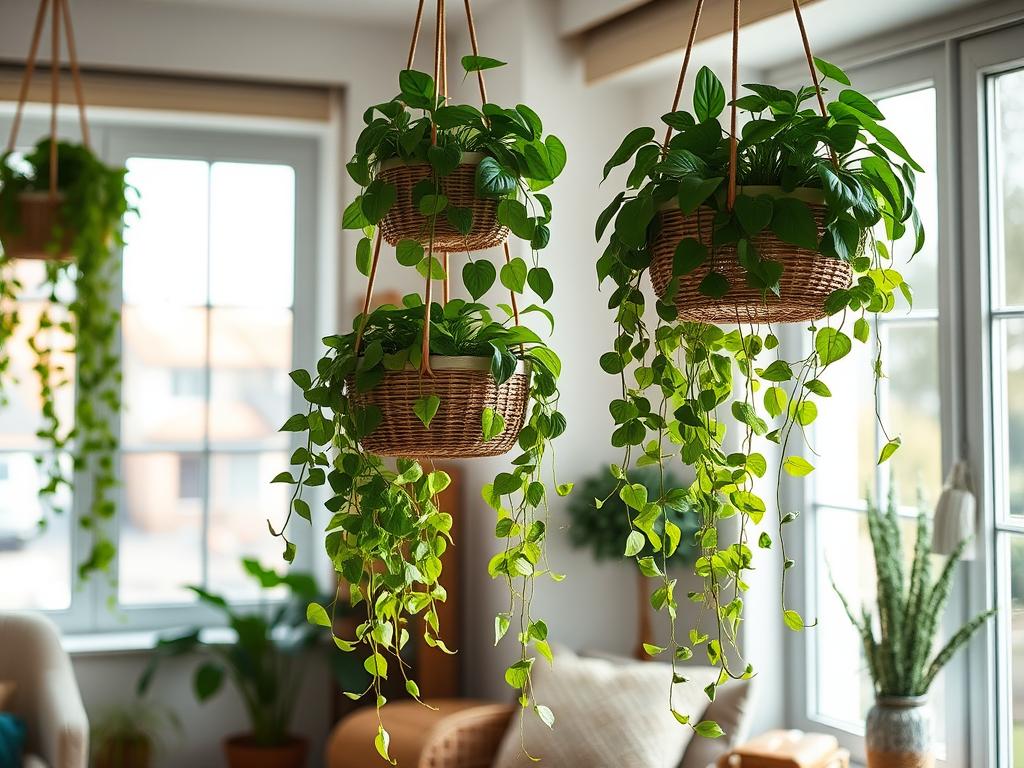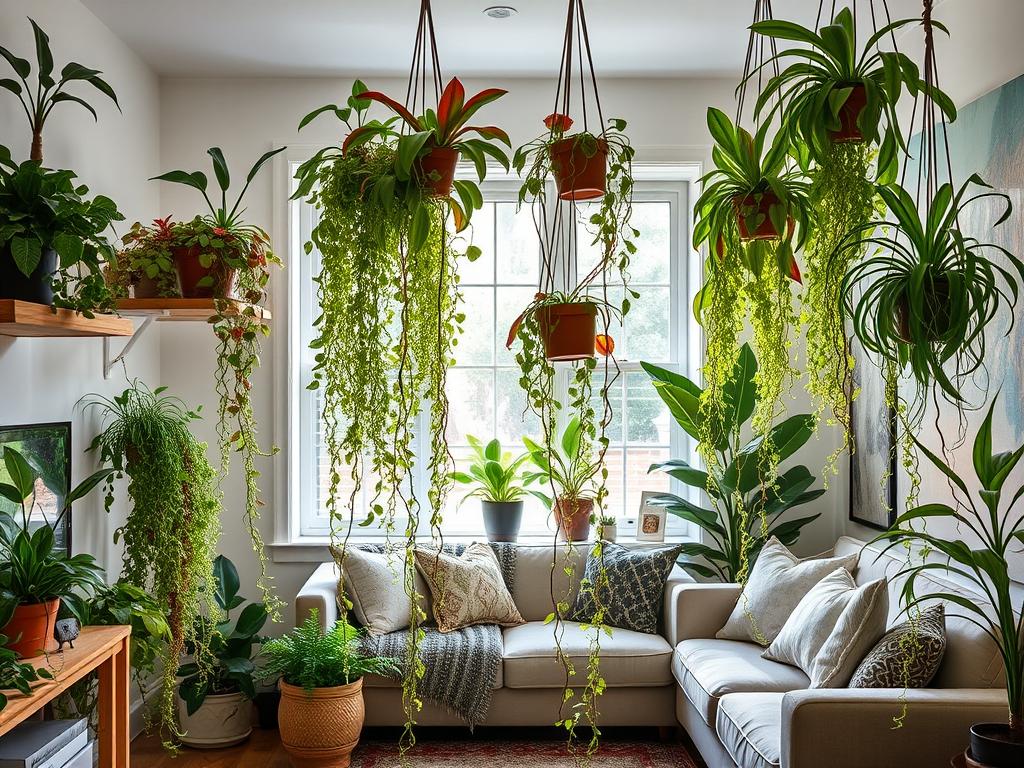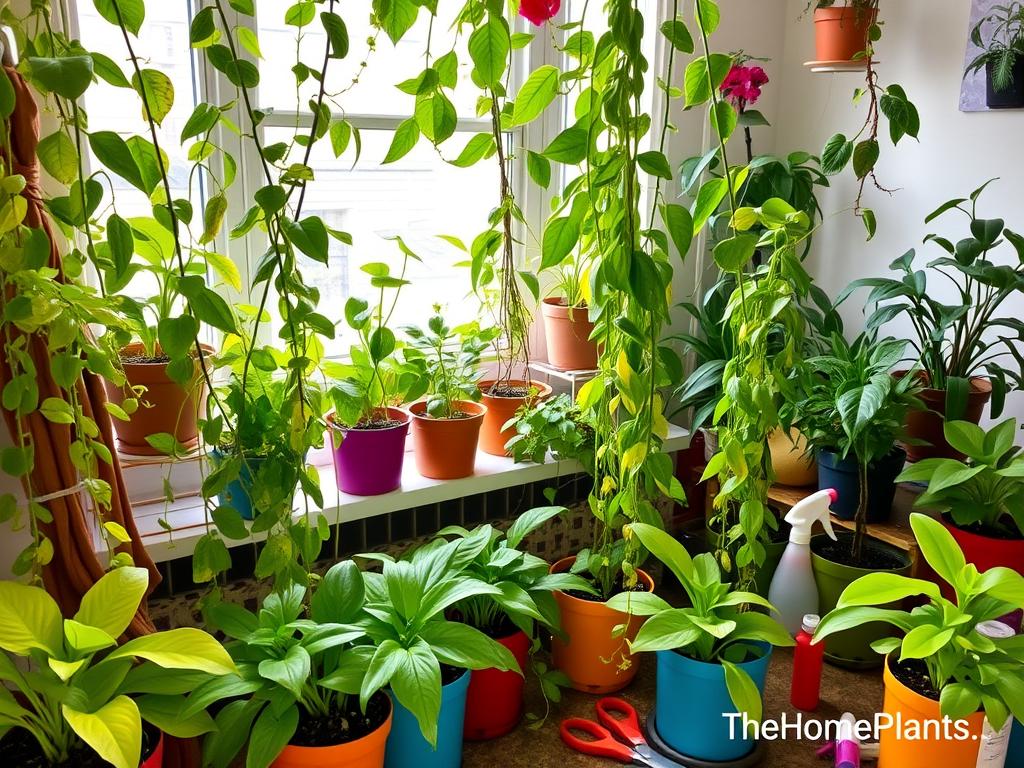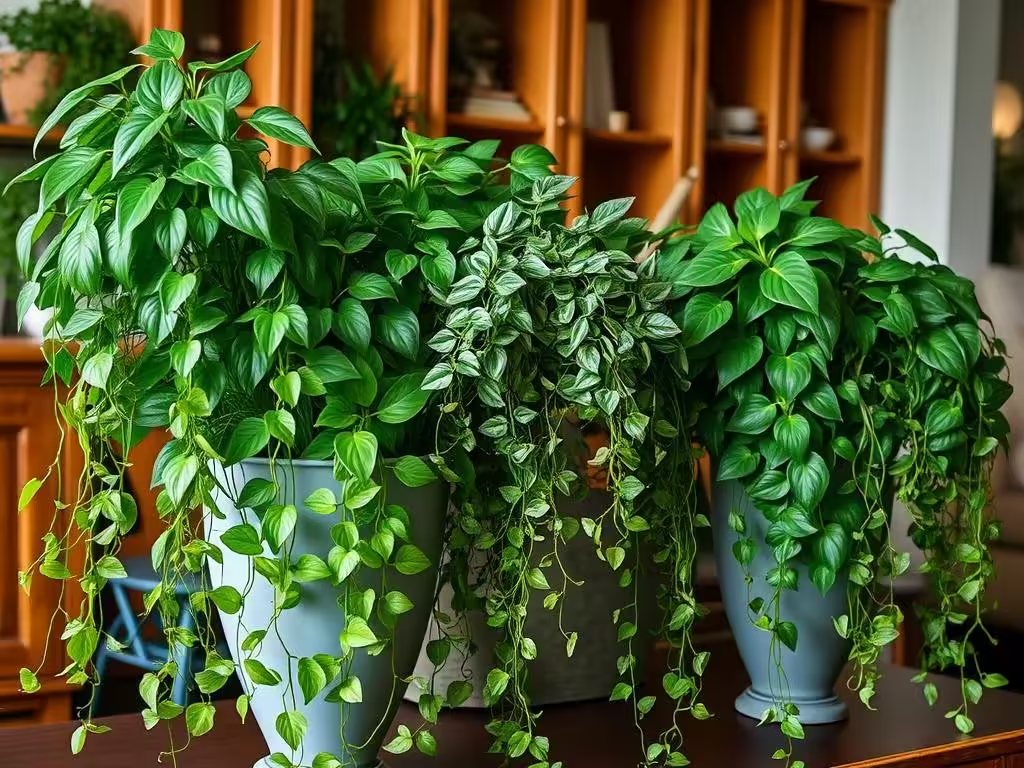Do you ever wish for a bit of green in your home? Trailing indoor plants can make your space more lively. They add warmth, texture, and natural beauty to any room. These plants can turn empty corners into beautiful spots and hide unsightly shelves.
Trailing plants bring elegance and life to your home. You can choose from plants like Devil’s Ivy or Chain of Hearts. Each has its own unique look and care needs. With the right care, these plants can make your home greener and healthier.
Key Takeaways
- Trailing indoor plants add beauty, texture, and life to any room
- They can be used to disguise clutter, enliven empty corners, and create a calming atmosphere
- Trailing plants come in a variety of species, suitable for different skill levels and light conditions
- Proper care, including watering, light, and occasional fertilization, is key to keeping trailing plants thriving
- Trailing plants can also help improve indoor air quality by removing harmful toxins
What are Trailing Indoor Plants?
Trailing indoor plants, also known as cascading or hanging plants, are a beautiful addition to any home. They have long, lush leaves that hang down from their pots. This creates a peaceful and eye-catching atmosphere. Plants like English ivy and wandering dude bring life and interest to your home.
Definition and Characteristics of Trailing Plants
Trailing plants grow long stems that flow over their containers or shelves. They love hanging baskets or shelves to spread out. Plants like devil’s ivy, chain of hearts, and heartleaf philodendron have unique leaves and growth patterns.
Benefits of Having Trailing Plants Indoors
- Enhance the visual appeal of a space with their lush, cascading foliage.
- Improve air quality by absorbing carbon dioxide and releasing oxygen.
- Create a calming and serene atmosphere, reducing stress and promoting relaxation.
- Offer versatility in indoor design, allowing you to incorporate trailing plants into a variety of decor styles.
- Provide a sense of movement and liveliness to any room, adding depth and dimension to the space.
Trailing indoor plants can make your home feel alive and peaceful. They bring a touch of nature indoors. By knowing what they are and their benefits, you can easily add them to your home.
Top Trailing Indoor Plants to Consider
Looking for the best trailing indoor plants? A few species really stand out. They’re easy to care for and can make your home look great with their vines and leaves. Here are three top picks:
Devil’s Ivy (Epipremnum aureum)
Devil’s ivy, or pothos, is super easy to grow. It has small, heart-shaped leaves with yellow patterns. This makes it a beautiful addition to any room. It grows fast and does well in different light, making it a great choice.
Chain of Hearts (Ceropegia woodii)
The chain of hearts, or string of hearts, is a fun plant. It has long, grey-green leaves that look like chains. It’s perfect for hanging over shelves or around the room, adding a playful touch.
Heartleaf Philodendron (Philodendron scandens)
The heartleaf philodendron is another great option. It has shiny, green leaves that are heart-shaped. This plant can trail or climb, making it versatile. It’s also easy to care for and works well in many indoor spots.
Devil’s ivy, chain of hearts, and heartleaf philodendron are all great for adding greenery to your home. They’re easy to care for and look beautiful. They’re sure to become your favorite plants.
Caring for trailing indoor plants
Bringing trailing indoor plants into your home needs some extra care. But the beauty they add is worth it. You’ll need to ensure the right light needs, proper watering and humidity, and the best soil and fertilizer. These steps will help your plants thrive.
Light Requirements
Most trailing plants love bright, indirect sunlight. Some, like Devil’s Ivy, can handle full sun. Others, like Heartleaf Philodendron, prefer lower light. A north-facing window is perfect for many varieties.
Watering and Humidity Needs
Watering needs vary, but water when the top inch of soil is dry. Avoid overwatering to prevent root rot. Keeping humidity right is also key. Mist the leaves or use a pebble tray to increase humidity.
Soil and Fertilizer Requirements
Use a well-draining potting mix with perlite or bark for aeration. Fertilize regularly during the growing season. But don’t overdo it to avoid nutrient burn.
Knowing your plants’ light, watering, and soil needs helps them flourish. This creates a vibrant display that brings nature indoors, enhancing your space.
Best Low-Light Trailing Indoor Plants
Not all trailing plants can handle low light, but some do well in dark spots. These plants can brighten up even the darkest corners of your home.
Some top picks for low-light trailing plants are:
- Epipremnum aureum (pothos) – These vines thrive in low light. Their vibrant leaves add lush greenery to any room.
- Philodendron hederaceum variegata (heart-leaf philodendron) – Its colorful leaves pop in low-light areas. It’s known for doing well in dim spaces.
- Scindapsus pictus (silver pothos) – This plant has silvery, speckled leaves. It’s perfect for rooms with little light.
- Syngonium podophyllum (arrowhead plant) – Its unique leaves and vines make it interesting in low-light spaces.
- Hedera helix (English ivy) – While it likes bright light, it can also do well in low light. It looks great in hanging baskets or on shelves.
- Maranta leuconeura variegata (prayer plant) – Its patterned leaves make it a standout in low-light areas.
- Nephrolepis exaltata (Boston fern) – This fern loves shady spots. It adds elegance to any room.
When picking low-light plants, think about their light, water, and humidity needs. This will help them stay healthy and beautiful in your home.
Pet-Friendly Trailing Indoor Plants
Decorating your home with trailing plants is fun, but keeping pets safe is key. Plants like Monstera, English ivy, and philodendrons can be harmful if pets eat them. Luckily, there are many safe options that let you enjoy beautiful greenery without worry.
Safe and Non-Toxic Options
There are many pet-friendly trailing plants to choose from. The Chinese Money Plant and Money Tree are great picks. The Money Tree grows fast and is very resilient, perfect for indoor plants.
Hoyas are also safe for pets and come in many colors and shapes. Boston Fern, Spider Plant, and Polka Dot Plant are non-toxic and great for trailing.
Always check the ASPCA‘s list of toxic and non-toxic plants before picking. This ensures your pets stay safe.
Even safe plants can be harmful if pets eat them. So, watch your pets and take good care of your plants. This includes watering and giving them the right amount of light.
Choosing the right pet-safe plants lets you enjoy beautiful greenery without risking your pets’ health. With some research and care, you can create a beautiful, safe space for your pets and plants.
Styling and Displaying trailing indoor plants
Trailing indoor plants can make your home look amazing. They add depth, texture, and natural beauty. These plants come in many styles, from vines to lush foliage. You can show them off in hanging baskets or mix them with your decor.
Creative Ideas for Hanging Baskets
Hanging baskets are a great way to display these plants. They let the plants flow down, making a beautiful sight. Think about the size and growth of your plants when choosing baskets.
Try mixing different plants like Devil’s Ivy and Chain of Hearts for a cool look. Hang baskets at different levels for a layered effect. Use baskets that match your home’s style, like rattan or metal. Don’t forget to water and drain them properly.
Incorporating Trailing Plants into Home Decor
Trailing plants can fit right into your home’s decor. Place them on shelves, bookcases, or even make a living wall. They can make hard lines in furniture and architecture look softer.
When placing plants, think about balance and size. Mix plants of different heights and widths for a natural look. Try different planters to match your home’s style.

“Trailing plants can transform the look and feel of your indoor environment.”
Trailing Indoor Plants For Beginners
If you’re new to indoor plants, there are easy-to-care-for trailing varieties perfect for beginners. These low-maintenance trailing houseplants need little effort but add natural beauty to your space.
Easy-Care Trailing Plants to Consider
Some top trailing plants for beginners include:
- Epipremnum aureum (Devil’s Ivy or Pothos) – This versatile vine is tough and grows well in different lights, great for new plant owners.
- Ceropegia woodii (Chain of Hearts) – Its delicate leaves and vines make the Chain of Hearts a lovely and easy trailing indoor plant for any room.
- Philodendron scandens (Heartleaf Philodendron) – The Heartleaf Philodendron is a classic, low-maintenance plant that does well in moderate light.
These easy-care trailing indoor plants are forgiving. They need moderate light, infrequent watering, and little special care. Starting with these plants helps you build your green thumb and feel ready for more challenging ones.
“With the right growing conditions and a little attention, even novice plant owners can enjoy the beauty and benefits of trailing indoor plants.”
Unique and Unusual Trailing Indoor Plants
Classic plants like ivy and philodendrons are loved for a reason. But, there are also unique and unusual plants for your home. The Fishbone Cactus has striking leaves that cascade. The Monstera adansonii, or “Monkey Mask,” has unique leaves. The Maranta leuconeura, or “Prayer Plant,” folds its leaves at night.
These rare or exotic trailing plants can make your space special. They add a unique touch to your indoor oasis.
The String of Pearls is a fast-growing succulent. It’s easy to propagate and grows well indoors and outdoors. The Lithops, or ‘living stones,’ are from southern Africa. They have a unique look.
The Prayer Plant can grow up to a foot tall indoors. It has beautiful leaves.
- The Staghorn Fern has fronds like antlers. It needs bright, indirect light and high humidity.
- The Chinese Money Plant, or Pancake Plant, is easy to grow. It adds a modern touch to your space.
- The Oxalis has purple heart-shaped leaves. It can revive itself in good conditions.
The Begonia Maculata has large leaves with polka dots. It’s a striking indoor plant. The Watermelon Peperomia has leaves like watermelon. It’s easy to grow.

The world of unique trailing indoor plants is vast. It offers endless ways to make your space special. By choosing these unusual cascading houseplants, you can make your home more beautiful.
Propagating and Growing trailing indoor plants
Do you want to grow more trailing indoor plants or share them with friends? You can easily do this by using simple techniques. You can use stem cuttings, division, or even leaf propagation. This way, you can grow new plants from your favorites, saving money and enjoying your garden more.
Start by using a potting mix that drains well. Make sure your plants get bright, indirect light and consistent moisture. With the right care, your plants will thrive and spread. This lets you enjoy their beautiful foliage all over your home.
Propagation Methods for Trailing Indoor Plants
- Stem Cuttings: For plants like pothos, Swedish ivy, and scented geraniums, take 2-3 inch stem cuttings.
- Leaf Propagation: African violets and rex begonias can be grown by taking a leaf, slicing it, and rooting it in moist mix or water.
- Division: Plants like snake plants and aloe vera can be split when they produce offshoots or pups.
- Seed Propagation: For slower growth, try growing asparagus fern and bromeliads from seed. They need the right sowing and transplanting conditions.
Choose the method that works best for you. Make sure to give your new plants the right care and environment. This will help them grow and thrive in your home.
| Propagation Method | Best Trailing Plants | Key Steps |
|---|---|---|
| Stem Cuttings | Pothos, Spider Plant, ZZ Plant | Take 2-3 inch stem cuttings, remove lower leaves, and root in moist potting mix or water. |
| Leaf Propagation | African Violet, Begonia, Peperomia | Remove a healthy leaf, slice through veins, and plant the leaf in moist potting mix or water. |
| Division | Snake Plant, Aloe Vera, Philodendron | Carefully divide the root ball of the plant, ensuring each new section has roots, and repot. |
| Seed Propagation | Asparagus Fern, Bromeliads, Coleus | Sow seeds in moist potting mix, maintain appropriate lighting, and transplant seedlings. |
Success in growing trailing plants comes from the right conditions and care. With patience and attention, you can multiply your plants. Then, you can share the beauty of these plants with others.
Troubleshooting Common Issues
Keeping your trailing indoor plants looking great can sometimes be tough. But, with a bit of troubleshooting, you can fix common problems fast. Issues like yellow leaves or wilting plants can be solved by knowing what causes them.
Overwatering
Overwatering is a big problem with these plants. They need less water than many other indoor plants. Too much water can cause root rot and fungal diseases. Water your plants when the soil is dry about 1/2 to 1 inch down. Don’t let the soil get too wet.
Insufficient light
Not enough lighting can also cause problems. These plants need bright, indirect light, not direct sunlight. If leaves are pale or white, it means they’re getting too much light. Move them to a spot with more shade.
Other Common Issues
- Pests like spider mites, mealybugs, and scale insects can infest trailing plants
- Nutrient deficiencies may result in yellowing leaves or stunted growth
- Consistent humidity is important, as low moisture can lead to crispy leaf edges
Common Problems, Causes And Solutions
Watching your plants closely and acting fast is crucial. Fixing problems like overwatering, poor light, pests, or nutrient issues helps your plants stay healthy. This way, they’ll keep looking lush and beautiful.
| Common Problem | Possible Causes | Solutions |
|---|---|---|
| Yellowing leaves | Overwatering, underwatering, nutrient deficiencies | Check soil moisture, adjust watering, fertilize with appropriate plant food |
| Wilting or drooping | Underwatering, overwatering, temperature stress | Water when soil is dry, ensure proper humidity, maintain ideal temperature range |
| Stunted growth | Insufficient light, root bound, pest infestations | Provide brighter light, repot if needed, treat for pests |
| Leaf discoloration | Sunburn, nutrient deficiencies, pests | Move to lower light, fertilize, inspect for and treat pests |
By being careful and fixing problems quickly, your trailing plants will keep thriving. They’ll stay lush and beautiful.

Conclusion
Trailing indoor plants can make your home look beautiful and lively. They add warmth, color, and life to any space. By choosing the right plants for your home, you can make it even more special.
These plants are easy to care for and can make your home healthier. They help clean the air and make your space feel calm. Plus, they can match any decor style you like.
Proper care is key to keeping your plants happy and healthy. This includes watering, fertilizing, and pruning them right. Also, watching out for pests and adjusting care with the seasons is important.
Joining online plant communities can help you learn more. You can share tips and experiences with other plant lovers. This way, you can keep your plants thriving and enjoy the journey.
FAQ
What are the benefits of having trailing indoor plants?
What are some of the most popular trailing indoor plants?
What are the light requirements for trailing indoor plants?
How do I care for trailing indoor plants?
Are there any pet-friendly trailing indoor plants?
How can I display trailing indoor plants in my home?
What are some easy-care trailing indoor plants for beginners?
Are there any unique or unusual trailing indoor plants to consider?
Source Links
- Trailing Indoor Plants to Enhance Your Home’s Look and Feel | Homes To Love
- 30 Best Indoor Plants to Liven Up Any Room
- The Comprehensive Guide to Trailing Indoor Plants — The Botanical Archive
- 12 Easy Trailing Houseplants
- Best indoor hanging plants – 12 trailing houseplants for cascading, statement foliage
- 10 Trailing Houseplants for a Shelf/Cabinet | THE HOUSEPLANT DOCTOR™
- The 17 Best Hanging Plants To Brighten Up Any Space
- 21 Hanging Indoor Plants to Liven up Your Vertical Space
- Flora | Indoor Vine Plants: Perfect for Hanging and Trailing
- 10 Trailing Houseplants for a Shelf/Cabinet | THE HOUSEPLANT DOCTOR™
- Designer-Favorite Houseplants That Can Thrive in Even the Darkest Rooms
- 31 Best Low-Light Indoor Plants to Brighten Up Your Home
- 22 Pet-Friendly Plants That Will Liven Up Your Space
- How to Arrange Plants In Your Living Room to Add Natural Style
- Easy Houseplants Even Beginners Can’t Kill
- 23 Best Hanging Plants for Every Room of Your House
- 22 Indoor Vining Plants That’ll Make Your Home Look Like a Jungle
- Our Recommended Hanging Plants Will Glam Up Any Space
- What’s Wrong with My Plant? How to Fix 10 Houseplant Problems
- How to Properly Care For Trailing Plants: Tips and Tricks From Seasoned Gardeners

